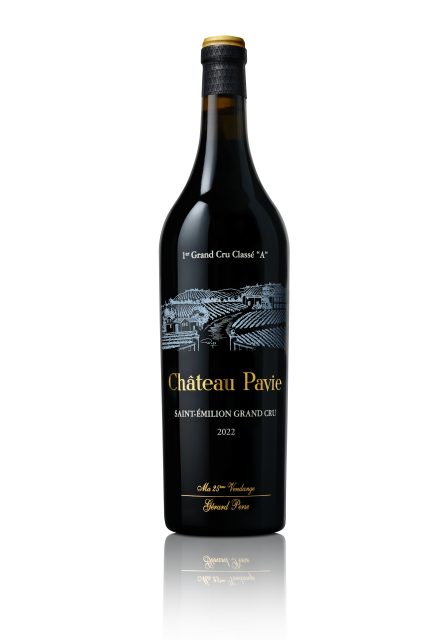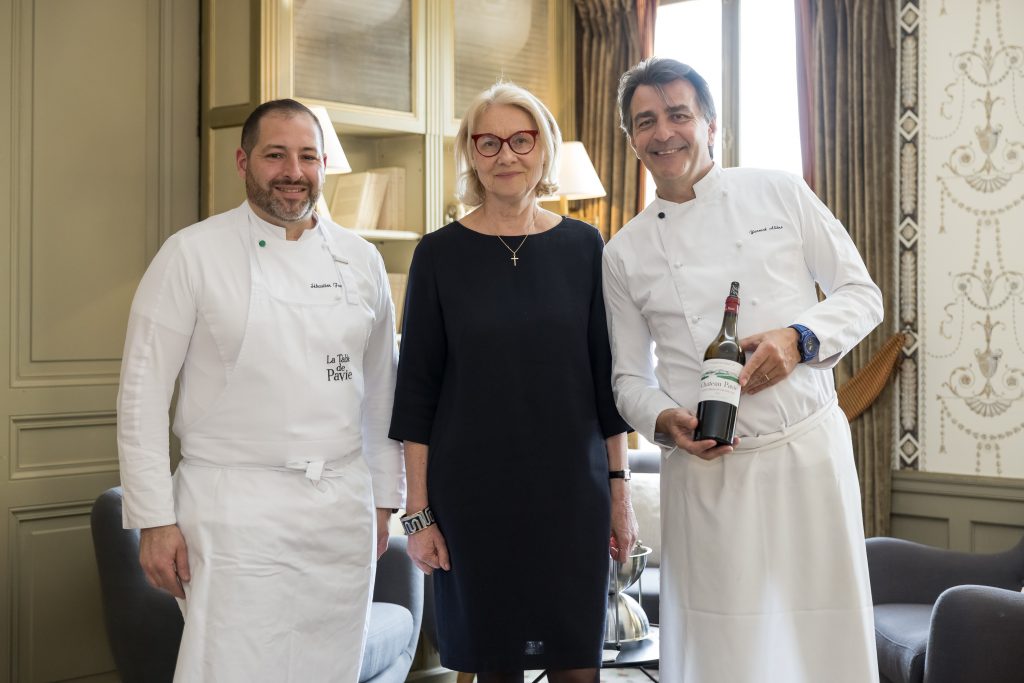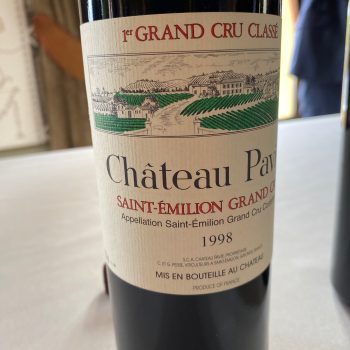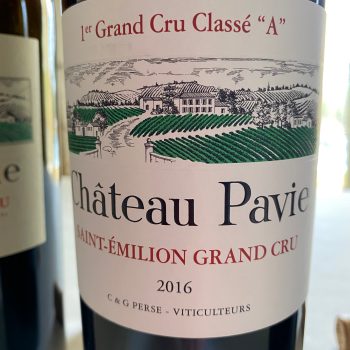The Perse family celebrates 25 years at Château Pavie as it releases special engraved bottle for the 2022 vintage
On the eve of the much-anticipated 2022 en primeur campaign, the Perse family celebrated its first 25 years at Château Pavie with a vertical tasting of Château Pavie and Monbousquet and a special lunch in Paris. Our Bordeaux correspondent Colin Hay was among the guests as it unveiled the new engraved bottle that will contain the 2022 vintage.

The history of Gêrard Perse in St Emilion and in the world of wine began 30 years ago in 1993 with the purchase of Château Monbousquet. His roots in St Emilion grew deeper with the acquisition, five years later, of Château Pavie. The vines of this most famous of estates are to be found on the ancient eponymous Côte first planted in the 4th Century and the plateau above. As Gêrard Perse himself explains, “from that moment onwards we have endeavoured to develop around our properties a complete way of living combining unique experiences and flavours”.
2023 marks a double anniversary for the Perse family – 30 years at Monbousquet and 25 years at Pavie. Both were celebrated last week at the lunch at Yannick Alleno’s 3* Pavillon Ledoyen in Paris with their son-in-law Henrique Da Costa who works alongside them, and in the company of invited friends, a number of international wine journalists and leading sommeliers.
As a prelude to lunch there was a tasting of a number of the vintages that have marked the history of the Grand Cru Classé, Château Monbousquet (2000, 2005, 2010, 2015, 2020) and the Premier Grand Cru Classé A, Château Pavie (1998, 2005, 2009, 2016, 2020). Though the two great terroirs express themselves very differently in each of these remarkable vintages, each wine has the clear ‘imprint’ of Gérard Perse.
“These properties were two sleeping beauties when they were acquired,” recalls Henrique Da Costa. “It was not a magic wand that brought them back to life but a lot of work. Pavie and Monbousquet were, at the time, two respected names of the appellation. All that remained was to make them shine (…) The gravelly terroir of Monbousquet offers us wines of a great finesse with magnificent fruit, round and silky tannins. At Château Pavie, over the years that we have learned to listen to and to elevate this magical terroir. The famous Côte Pavie with its full southern-exposure yields Cabernet-Sauvignon that gives us today a delicate fruitiness and floral notes. And the limestone plateau of Saint Emilion brings to the wine a saline minerality and great depth. Today our wines offer a perfect balance, they are elegant, intense and harmonious wines, wines made for to accompany us over time”.
To mark the occasion, Yannick Alléno shared his kitchens at Pavillon Ledoyen with Sébastien Faramond, executive chef at the Table de Pavie in St Emilion. To accompany a further selection of the most emblematic vintages of Château Monbousquet (the white from 2019 and the red from 2009) and Château Pavie (the 2000 and 2010), they together prepared a tailor-made menu of four courses, including a simply brilliant rendition of the regional classic, Lamproie à la Bordelaise, followed by a rack of lamb in fleur de sel, white asparagus and preserved clementine accompanied by a lamb jus pearled with chorizo.

The next big event on the Perse family’s calendar is, of course, en primeur week, which will be held from 24 – 27 April. The 2022 vintage that will be presented also marks the tenth anniversary of the promotion of Château Pavie to Premier Grand Cru Classé A. It also brings, for the first time, the incorporation of the contiguous terroirs of Pavie Decesse and Bellevue Mondotte.
We will have to wait a few weeks longer to taste it. But we know already that this most emblematic of vintages for Château Pavie will be presented in a special bottle engraved in black and gold.
Key dates for the Perse family in St Emilion
1993 – the first Perse vintage of Château Monbousquet
1998 – the first Perse vintage of Château Pavie
2000 – an historic vintage with 100 points from Robert Parker for Château Pavie
2001 –the purchase of l’Hostellerie de Plaisance in Saint-Emilion
2005 – Angélique and Henrique Da Costa join Gerard and Chantal Perse in Saint-Emilion; another 100 points from Robert Parker for Château Pavie
2006 – Monbousquet is promoted to the rank of Grand Cru Classé
2009 – another 100 points from Robert Parker for Château Pavie
2010 – another 100 points from Robert Parker for Château Pavie
2012 – Pavie is promoted to the rank of Premier Grand Cru Classé A
2013 – The inauguration of the new cellars of Pavie designed by Alberto Pinto
Partner Content
2015 – Pavie’s first harvest of honey; another exceptional vintage
2016 – another 100 points from The Wine Advocate for Château Pavie
2017 – The bistro L’Envers du Décor opens in St Emilion
2020 – Yannick Alléno arrives at the Hostellerie de Plaisance, renamed the Hôtel de Pavie, and takes over the reins in the kitchen of La Table de Pavie (retaining two Michelin stars).
Tasting notes
- Monbousquet 2000 (60% Merlot; 30% Cabernet Franc; 10% Cabernet Sauvignon; a final yield of 30 hl/ha; aged in 100% new oak for 18 months). Creamily-textured with rich dark berry fruit and a little plum which builds in prominence with aeration. Liquorice; sage; cinnamon. This is fine, quite elegant and impressively pure given the richness. Plump and distinctly spicy, though this has aged perhaps a little more rapidly that you might have imagined. I like especially the subtle floral notes. The tannins remain quite chewy and shade a little towards dryness on the finish. Overall, this is deep, rich and ample; it is well-sustained and remains broad-shouldered all the way on the finish. 92.
- Monbousquet 2005 (60% Merlot; 30% Cabernet Franc; 10% Cabernet; 13.5% alcohol). This is distinctly fresher on the nose and is also more complex and slightly more lightly spiced, with the pepper notes more evident as a consequence. The fruit is also a shade or two darker, more berry than plum (blackberry and blueberry). Tighter, a little narrower and less oaky. The minerality is more present – a little ferrous with crushed rock notes evident too. The oak is actually a little more obvious on the palate than the nose. This is tender and crumbly on the nicely shaped and tighter, tauter finish. This feels a lot younger and with a lot more life ahead of it than the 2000. 93.
- Monbousquet 2009 (70% Merlot; 20% Cabernet Franc; 10% Cabernet Sauvignon; 14.2% alcohol). Saved for the lunch and you can see why. For me, this is very much the best of these. Dark, rich, very plummy, sunny but not overly so. This is magisterial in terms of depth and concentration but never feels saturated, with excellent mid-palate delineation – if not, of course, that of Pavie itself. There’s a nice sense of pick up and forward momentum in the mouth that comes from the freshness here. It cuts through the richness and gives this energy. This has more structure and shape than the others – and more concentration too. Dark, slightly sombre with a lovely touch of cedar and, again, that sense of freshness. Thi is cool and mentholated on the finish. 94.
- Monbousquet 2010 (70% Merlot; 20% Cabernet Franc; 10% Cabernet Sauvignon; 14% alcohol). Bolder, richer, broader and more ample but fresher still – like a hypothetical combination of the 2000 and the 2005. This is less spicy and a shade cooler in the mouth. There’s also more cedar, and this comes through more and more in the glass with gentle aeration. The wine passes quickly through a slightly reductive phase, revealing sandalwood and candlewax notes alongside the now recognisable plum, damson and mulberry fruit. Darker and almost a little strict, with substantial tannins only half way to their resolution. Long and a with well-defined sense of a dense, dark fruit-filled core to it. A little more austere and darker fruiter on the palate than 2005 and somewhat less seductive. Very close in quality of the 2009. 93.
- Monbousquet 2015 (60% Merlot; 30% Cabernet Franc; 10% Cabernet Sauvignon; aged in oak barrels, 70% of which were new). Sunny, as you would expect. Vanilla, spice-box, toasted brioche, even caramel. This is quite oaky too. Prominent baked plum notes. Quite tender, plump and ample – if, in comparison to the 2009 or 2010, a little shapeless and with that hot spiciness of the vintage – curry leaf and cumin alongside the saline hoisin plummy notes. There’s a pleasing complexity from the touch of Szechuan peppery-ness. With a fair bit of tannin still to resolve, this is very much a vin de garde, though the nose is a little more evolved. 92.
- Monbousquet 2020 (70% Merlot; 15% Cabernet Franc; 15% Cabernet Sauvignon; aged in oak barrels, 50% of which were new; 14.7% alcohol). Fresh, bright, crunchier and with the darkest fruit profile of this mini-vertical tasting – with more berry and plum skin than baked plum notes (when compared with the 2015). Mulberry, cassis, bramble; graphite too. There’s a gentle toasty-ness from the oak – but this feels more subtle. I find this more balanced and harmonious then when first encountered en primeur and a little less oaky too. There’s a nice sense of the freshness and lift of the vintage and I find this more crystalline too. Pure, precise, nicely structured and quite fluid over the palate. This also has finer-grained but still considerable tannins. As good a vintage of Monbousquet as I have tasted. 94.

- Pavie 1998 (60% Merlot; 30% Cabernet Franc; 10% Cabernet Sauvignon). Gracious yet seductive, tense yet ample and rich yet well-defined and well-structured. Opulent and elegant in its power. A little toasty note remains. Subtle salinity and an earthy minerality; creamy and full, fresh and quite floral. Impressively young on the nose and palate (Parker sees this as a 50-year wine and on that reckoning we’d at half distance). There’s a lovely pick-up on the palate and the sapidity is as crucial to the structure of the wine at this stage as the tannins. It is still a little oaky perhaps and was made in a different epoch. Floral – with pot pourri notes evident on the palate and crushed petals and rose-water too. Baked plum, the fruit profile a little less fresh than in later vintages and, in fact, more evolved than on the nose. Cinnamon and nutmeg. This is long and rolling on the finish, juicy at the very end, with a lovely final tannic pinch releasing a little plume of juiciness as a parting crescendo. Lovely if not at the same level as more recent vintages and very much a creature of its time. 96+.
- Pavie 2000 (60% Merlot; 30% Cabernet Franc; 10% Cabernet Sauvignon). This was held back for lunch and, just like Monbousquet 2009, you can see why. This, for me, is the (perhaps surprising) star of the older vintages. What impresses me most is that it is super fresh and floral. Peonies and rose petals. Lovely fresh raspberry and mulberry alongside the more secondary elements. Soft and ready, rather more voluptuous and unctuous than the other vintages – with a little less mid-palate density but so much guile and finesse and elegance to compensate – and more freshness than either the 1998 or the 2005. It is more poised at this stage too, though the 2005 will no doubt outlive it. This is the most complete and resolved of the set. Brilliant and somewhat exceeding my expectations. 99.
- Pavie 2005 (70% Merlot; 20% Cabernet Franc; 10% Cabernet Sauvignon). This, too, is glorious. A very different style to today (as one appreciates all the more as one gets further into this rare and wondrous vertical tasting). It’s sunny (‘solaire’ is the French word here which captures this better than the English). But it’s also so fresh and bright and crystalline directly from the nose. Creamy, yes, but here that somehow accentuates the fresh and confit petal florality. Cedar and graphite notes are also much in evidence. But this is much oakier than it would be nowadays. That masks somethings and reinforces others, turning for instance the floral elements more towards dried, confit and pot pourri notes. Dark berry and stone fruit; but a little raspberry and even redcurrant freshness too to leaven this. Those pot pourri and dried rose petals notes are striking and there’s a hint of confit violet. This is gracious and ample, opulent in a way but with tension coming from the lovely freshness from start to finish. That finish is just a little chewy and there are plenty of tannins still to resolve, but they’re fine-grained and contribute to the exceptional length – sculpting a central column of graphic proportions all the way to the horizon. Magisterial. 97.
- Pavie 2009 (70% Merlot; 20% Cabernet Franc; 10% Cabernet Sauvignon; aged entirely in new oak). Sunny, warm and seductive, a little reductive at first but that passes – though it takes a bit of time. Lovely when it does. Like the 2005, there’s a bright and crisp freshness to this and a very complex fruit profile once again. Pronounced saline notes, especially on the first encounter, though they settle too – this is actually quite dynamic and evolves quickly in the glass with air. There’s a subtle toastiness. Quite relaxed and composed; full and soft and voluptuous – the most voluptuous of all of these great vintages as you might expect. Dark plums and red berries. Lots of bright fruit. Chewy and, interestingly, the tannins form little vertical plumes in the mouth projecting the fresh juicy fruit upwards like drinking fountains. This produces a very tactile effect in the mouth giving this great energy and dynamism to the mid-palate and finish. Incredibly fresh and rather more serious than it first appears as it opens – almost turning towards the 2010 in personality and losing a little that sunny side from the nose. 98.
- Pavie 2010 (70% Merlot; 20% Cabernet Franc; 10% Cabernet Sauvignon; aged entirely in new oak). I prefer Monbousquet 2009 to 2010 but Pavie 2010 to 2009. This looks amazing in the glass with a crystalline pink/purple radiance from the rim, black highlights and incredible viscosity and limpidity heralding the depth and concentration of the plunge-pool mid-palate. This looks – still – like an en primeur sample. The nose is closed and introvert at first (and at second and at third … !). Lots of graphite and very dark fruited – damsons, sloes, blueberry and cassis – this has wonderful precision and purity. Cedar and a brilliant dark crunchy fruitiness. So fresh and brilliantly chiselled. Very dense and concentrated but luminous too and with impressive fluidity, this evolves like the meandering of a great river. Long and fabulous. There’s a little menthol on the finish and violets too, reinforcing the sense of cool precision and focus. Gosh this is good! 99.

- Pavie 2016 (60% Merlot; 22% Cabernet Franc; 18% Cabernet Sauvignon; aged in oak barrels, 70% of them new). Wondrous. Serious. Refined and just a little held-back at first. A brilliant wine and perhaps the pick of these (which is already to say quite a lot). This is ultra-pure, almost laser-like in its precision. Lifted and bright with deceptive power and richness. Monumental in construction, but so finely chiselled it feels like it’s been mouldered rather than crafted with a blade. Green and pink peppercorns, Szechuan spices, crushed rock mineral notes too; a little hint of peony; and an attractive loamy earthiness; graphite rather than cedar. Lovely balance and harmony. Damson and assorted dark berry fruits – so crunchy and fresh and bright and juicy; there’s dark cherry and cherry skin, with the skin bringing almost the first sensation of the arrival of the tannins that accompany the evolution of the wine over the palate. Fine pixilation, great delineation and definition. Utterly brilliant and an object lesson in the greatness of its terroir and the vintage. 100.
- Pavie 2020 (50% Merlot; 34% Cabernet Franc; 16% Cabernet Sauvignon; aged in oak barrels, 75% of which are new). This is rather different and I actually like it even more than the others – though I suspect the 2016 shades it in quality. Loads of vertical lift. Quite smoky. Cinders, incense, floral notes too – violet and peony again. A very dark berry fruit profile. This is cool, poised and very pure, as en primeur. But today it is more open and expressive than when first encountered. The nose is sublime – blueberries, cassis, cherries, damsons, walnuts, wild herbs, gorse and heather, a hint of slightly sweeter spices and crushed fennel seeds. There are lovely dark graphite notes too and a hint of cedar and acacia. The use of oak is very subtle. On the palate, this is both spectacularly luminous but also richly layered. It is compact, dense in and through the mid-palate and then wonderfully sapid and fresh towards the finish which is comprised of a series of alternating ripples and larger waves of bright, crunchy juicy fruit. It seems eternal. A great expression of a singular vintage. 99.
Related news
Castel Group leadership coup escalates
For the twelfth day of Christmas...
Zuccardi Valle de Uco: textured, unique and revolutionary wines




